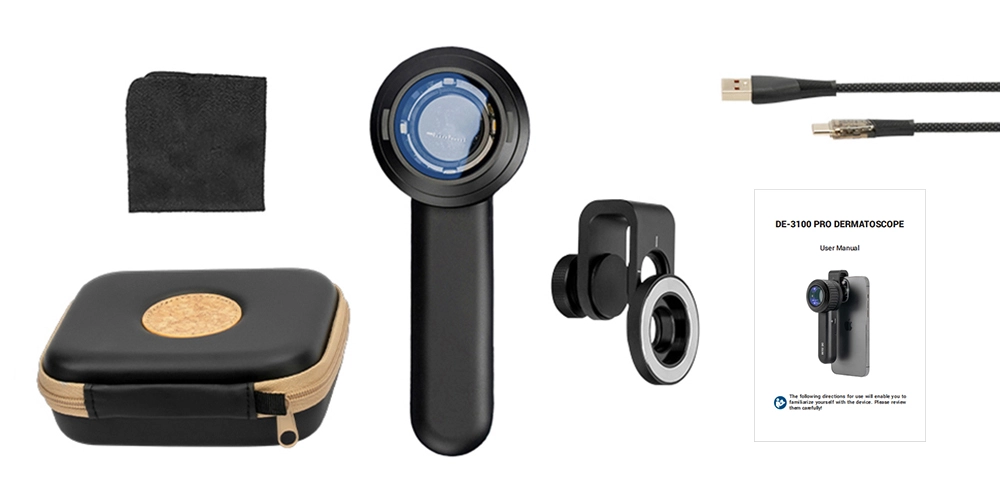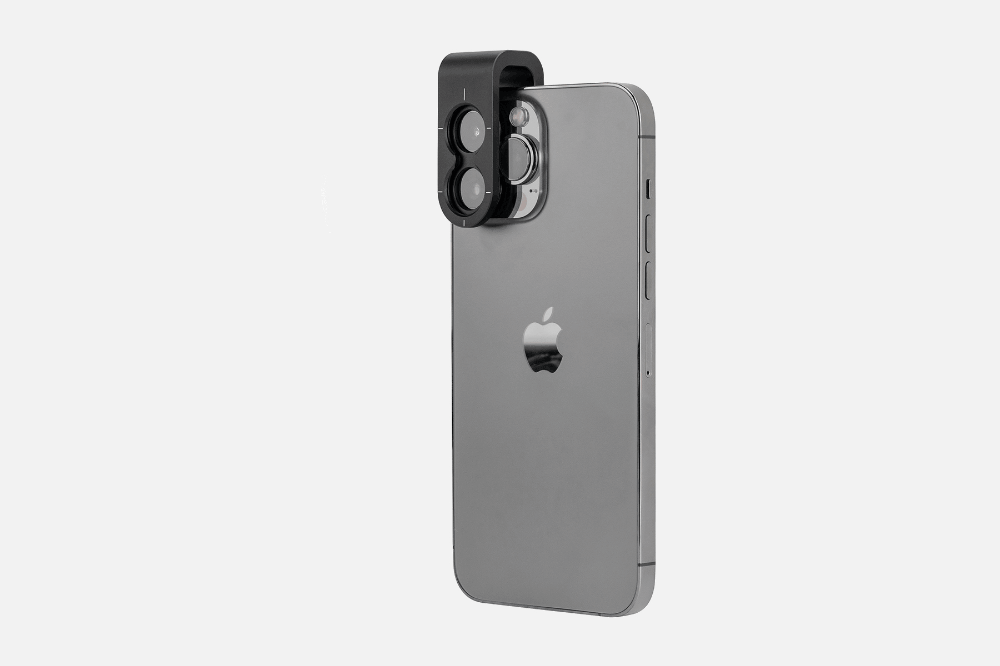Subtotal: $39.00
Polarized & 365nm UV LED DE-3100 PRO Dermatoscope
Polarized & 365nm UV LED DE-3100 PRO Dermatoscope
$599.00
-
In Stock
-
Arrive in 5-7 days
-
Free Shipping Worldwide $59+
-
2 Years Warranty
- 10 x Magnification
- 32mm wide field of view (Aperture)
- Polarized, non-polarized, and 365nm UV light illumination
- Detachable protective glass
- Automatic shutdown
- Included adapter fits all phone
- Bright LED illumination lights
- All-metal housing
| Material | Aluminum & Glass |
| Optical Design | All glass, 4 elements 3 groups, anti-reflection coating |
| Lens Diameter | 32mm(front); 25mm(rear) |
| Magnification | 10x |
| Distortion | 8% |
| Polarization | Cross Polarization |
| Resolution | 300 LP/MM (Axis) 280 LP/MM (Edges) |
| LED | 16 LEDs, 8 polarization, 4 non polarization, 4 365nm UV light |
| Ultraviolet Wavelength | 365nm |
| Battery Capacity | 1000mAh Lithium ion |
| Charging | USB-C |
| Working Time | 6-8 hours |
| Focus Distance | 12-20mm |
| Dimension | Φ53mm*H35mm*L136.5mm |
| Weight | 185g |
$599.00
-
In Stock
-
Arrive in 5-7 days
-
Free Shipping Worldwide $59+
-
2 Years Warranty
Related documents & accessories
-
Cross Infection Protector for DE-3100
$3.90 – $14.90
-
Case for iPhone
$15.90
Related documents & accessories
Cross Infection Protector for DE-3100
$3.90 – $14.90
Case for iPhone
$15.90
How to Use
Check out our step-by step quick start guide of the device.
What Makes it Unique
It’s a handheld dermatoscope, but it contains a universal phone adapter meaning convenient to connect with any smartphone or tablet to capture images. Build with 4K resolution optics, polarized light, ultraviolet light, 10X magnification and 25mm wide field of view — the DE-3100 PRO is perhaps the most super value dermatoscope we’ve ever seen. The visual filed is smaller(22%) than DE-4100, but the weight is 40% lighter.
Why Choose IBOOLO DE-3100 Pro
Cross Polarization
In polarization mode, the polarization filter becomes activated and absorbs the surface light reflection (no immersion fluid required). It allows you to examine the colours, shapes and texture features of the skin lesion more clearly, more precise and more detailed.
Woods Lamp
The DE-3100 PRO has Woods Mode that uses 365nm UV light to detect bacterial or fungal skin infections. It also can detect skin pigment disorders such as vitiligo and other skin irregularities.
UV light is used in dermoscopy for ultraviolet induced fluorescence dermoscopy (UVFD) to improve the diagnosis of various skin conditions by using its ability to make certain substances fluoresce. This is helpful for identifying and assessing skin cancers like melanoma, non-cancerous lesions such as porokeratosis, inflammatory diseases, and infections.
Easy to Use
The magnet attachment gives the ability to attach on smartphone and take pictures in 5 seconds.
Best part? It compatible with all phone in the market, with a universal lens clip or a phone cover for easy on and off.
Focus adjustable. It’s able to adjust working distance of different phone cameras. This enables the best image capture effect to be achieved.
DE-3100 PRO Dermatoscope Camera: Advanced Skin Imaging Device - IBOOLO
The IBOOLO DE-3100 PRO dermatoscope camera features 10x/20x magnification, polarized & UV lighting for detailed skin analysis. This professional-grade tool provides high-resolution imaging for accurate observation in clinical settings.
The Comprehensive Guide to Dermatoscope Cameras: Technology, Applications and Future Trends
The Evolution of Skin Imaging Technology
Dermatoscope cameras represent a significant advancement in skin imaging technology, bridging the gap between professional medical equipment and accessible healthcare tools. These specialized devices combine precision optics with digital imaging capabilities to provide detailed visualization of skin structures that would otherwise be invisible to the naked eye. Unlike conventional imaging systems, dermatoscope cameras integrate advanced lighting techniques with magnification to reveal subsurface skin features, serving as valuable observation tools that assist medical professionals in their evaluation processes. For manufacturers and engineers, understanding these devices involves appreciating their optical engineering, electronic components, and ergonomic design principles that make them both functional and user-friendly.
What Is a Dermatoscope Camera?
A dermatoscope camera is a hybrid optical-digital device designed specifically for skin surface microscopy. These systems typically consist of:
- Optical assembly: High-quality lenses providing 10x-100x magnification with minimal distortion
- Illumination system: Polarized and non-polarized LED arrays (usually 400-1000nm wavelength range)
- Image sensor: High-resolution CMOS detectors (typically 12-20MP) with specialized coatings
- Housing: Ergonomic designs incorporating medical-grade materials
Modern dermatoscope cameras differ from traditional dermatoscopes by incorporating digital imaging capabilities, allowing for image capture, storage, and analysis. The transition from analog to digital systems has enabled new applications in telemedicine and longitudinal tracking of skin conditions.
How Dermatoscope Cameras Work: Optical Principles
The imaging process in dermatoscope cameras involves several technical stages:
- Light delivery: Polarized light penetrates the stratum corneum while reducing surface glare
- Magnification: Multi-element lens systems enlarge skin structures while maintaining focus depth
- Image capture: Sensors convert optical information into digital signals
- Processing: Algorithms enhance contrast and reduce noise
Key optical challenges in dermatoscope camera design include minimizing chromatic aberration (typically kept below 1.5%) and maintaining consistent illumination across the field of view (uniformity >90%). Advanced models incorporate liquid lens technology for dynamic focus adjustment without moving parts.
Why Dermatoscope Cameras Matter in Modern Healthcare
These devices have become essential tools for several reasons:
- Early detection support: Provide visualization of microstructures like pigment networks
- Documentation: Enable tracking of lesion changes over time with quantitative metrics
- Telemedicine: Facilitate remote consultations with diagnostic-quality images
- Education: Serve as teaching tools for medical trainees
Clinical studies show that when used properly by trained professionals, dermatoscope cameras can improve observational accuracy by up to 30% compared to unaided visual examination. However, they remain supplementary tools that require expert interpretation.
Key Components in Dermatoscope Camera Manufacturing
For engineers, understanding the critical subsystems is essential:
| Component | Technical Specifications | Manufacturing Considerations |
|---|---|---|
| Optical Lens | 10-100x magnification, <1% distortion | Precision grinding, multi-layer coatings |
| LED Array | Polarized/non-polarized modes, 450-950nm | Thermal management, uniform illumination |
| Image Sensor | 1"-1/2.3" CMOS, 12-20MP | Low-light performance, noise reduction |
| Housing | IP54 or better, <500g | Medical-grade plastics, ergonomic design |
Can AI Enhance Dermatoscope Camera Capabilities?
The integration of artificial intelligence with dermatoscope cameras is transforming their applications:
- Feature detection: Algorithms can highlight concerning patterns in pigmentation
- Quantitative analysis: Measure lesion parameters with 0.1mm precision
- Workflow optimization: Automate image documentation and reporting
Current AI implementations typically use convolutional neural networks trained on thousands of annotated images. While these systems can achieve >90% sensitivity in controlled studies, they are designed as assistive tools rather than autonomous diagnostic systems.
Design Challenges in Dermatoscope Camera Development
Engineers face several technical hurdles when developing these devices:
- Optical performance: Balancing magnification with depth of field
- Portability: Maintaining image quality in compact form factors
- Sterilization: Creating housings that withstand repeated disinfection
- Power management: Optimizing battery life for clinical use
Emerging solutions include:
- Hybrid aspheric lenses for better aberration control
- Wireless charging for improved usability
- Nano-coatings for durable anti-fog surfaces
Future Trends in Dermatoscope Camera Technology
The next generation of devices will likely incorporate:
- Multispectral imaging: Capturing data beyond visible spectrum
- 3D reconstruction: Creating depth maps of lesions
- Augmented reality: Overlaying reference images during examination
- Modular designs: Swappable components for different applications
Manufacturers are also exploring graphene-based sensors and quantum dot technologies that could dramatically improve image quality while reducing power consumption.
Quality Assurance in Dermatoscope Camera Production
Rigorous testing protocols ensure device reliability:
- Optical testing: MTF measurements, distortion analysis
- Mechanical testing: Drop tests, button cycle testing
- Environmental testing: Temperature/humidity cycling
- Clinical validation: Image quality assessments by dermatologists
Typical production yields for premium dermatoscope cameras range from 85-92%, with most defects related to optical alignment or illumination uniformity.
Regulatory Considerations for Manufacturers
Dermatoscope cameras typically fall under these classifications:
- FDA Class I (US): General controls for non-diagnostic devices
- Class IIa (EU): Requires technical documentation and clinical evaluation
- ISO 13485: Quality management system requirements
Proper labeling must clarify that these are "auxiliary observation devices" rather than diagnostic systems. Recent regulatory updates have emphasized the need for robust cybersecurity in network-connected models.
Maintenance and Calibration Best Practices
To maintain optimal performance:
- Daily: Clean lenses with approved solutions; inspect housing
- Monthly: Verify illumination uniformity; check focus mechanism
- Annually: Professional calibration of optical and imaging systems
Common service issues include LED degradation (typically after 5,000 hours) and connector wear from repeated disconnection. Modern designs are addressing these with more durable components.
Economic Aspects of Dermatoscope Camera Production
The manufacturing cost breakdown for a mid-range model:
- Optical components: 35-45%
- Electronics: 25-30%
- Housing/materials: 15-20%
- Software/R&D: 10-15%
With the global market projected to reach $1.2 billion by 2027, manufacturers are balancing premium features with cost-effective production methods like automated optical alignment systems.
A Picture Speaks a Thousand Words
Toggle to hold the "after" image


How Does it Compare
There’s an influx of dermatoscope on the market. Our devices are remarkable blend of pro-level features and affordable price. Their premium optics and efficient LED system delivers sharp & precise images.
- OPTICAL DESIGN
- LENS DIAMETER
- MAGNIFICATION
- LIGHTING SYSTERM
- BATTERY
- CONNECTABILITY
- ADJUSTABLE
- COST

| Product | LENS DIAMETER | OPTICAL DESIGN | MAGNIFICATION | LIGHTING SYSTERM | BATTERY | CONNECTABILITY | ADJUSTABLE | COST |
|---|---|---|---|---|---|---|---|---|
DE-4100 PRO |
48mm/32mm | 4 elements 3 groups | 10 times | 26 LEDs, polarise, non polarise, amber light, UV light | 1000mAh | naked eye, phone, tablet, digital camera | focus & brightness | $799.00 |
DE-3100 PRO |
32mm/25mm | 4 elements 3 groups | 10 times | 16 LEDs, polarise, non polarise, UV light | 1000mAh | naked eye, phone, tablet, digital camera | focus | $599.00 |
DE-3100 |
32mm/25mm | 4 elements 3 groups | 10 times | 30 LEDs, polarise, non polarise, amber light | 1000mAh | naked eye, phone, tablet, digital camera | focus | $499.00 |
DE-500 |
25mm/17mm | 4 elements 3 groups | 10 times | 16 LEDs, polarise, non polarise, UV light | 200mAh | smartphone & tablet | brightness | $399.00 |
What’s in the Box?

- DE-3100 PRO Dermatoscope
- Magnetic Phone Adapter
- Charging Cable
- Clean Cloth
- Carrying Case
- User Manual
Shot on Spot
Reviews
1 review for DE-3100 PRO Dermatoscope
Only logged in customers who have purchased this product may leave a review.
Learn More
What Can a Wood’s Lamp Be Used For
A Wood’s lamp is a diagnostic device that emits long-wave ultraviolet (UV) light, typically in the range of 320 to 450 nm, with a peak emission around 365nm. When this…
How to Differentiate Rosacea, Acne, and Eczema?
The skin, as the body’s largest organ, is susceptible to a myriad of inflammatory conditions. Among the most common are rosacea, acne, and eczema, which frequently present with overlapping symptoms…
Skin Lesions Under IBOOLO DE-3100 Dermoscope
The DE-3100 is the first handheld optical dermatoscope launched by IBOOLO. It is a fully functional and highly practical dermatoscope. Why You Should Buy the IBOOLO DE-3100? The IBOOLO DE-3100…


 Small Contact Plate for DE-3100
Small Contact Plate for DE-3100 






















































Paul Muskett Australia
–
Australia
–
It is an excellent Dermatoscope and Mini only in the name. The visual field is large and optical quality excellent.